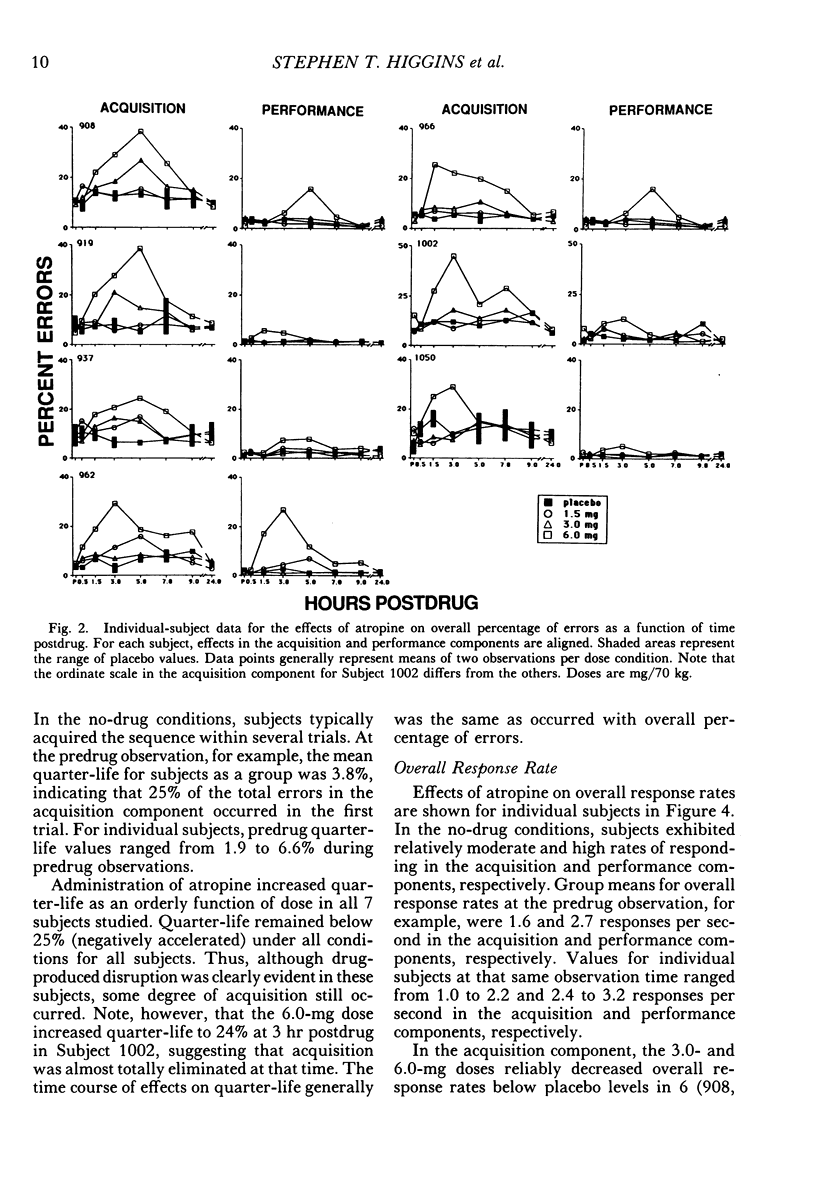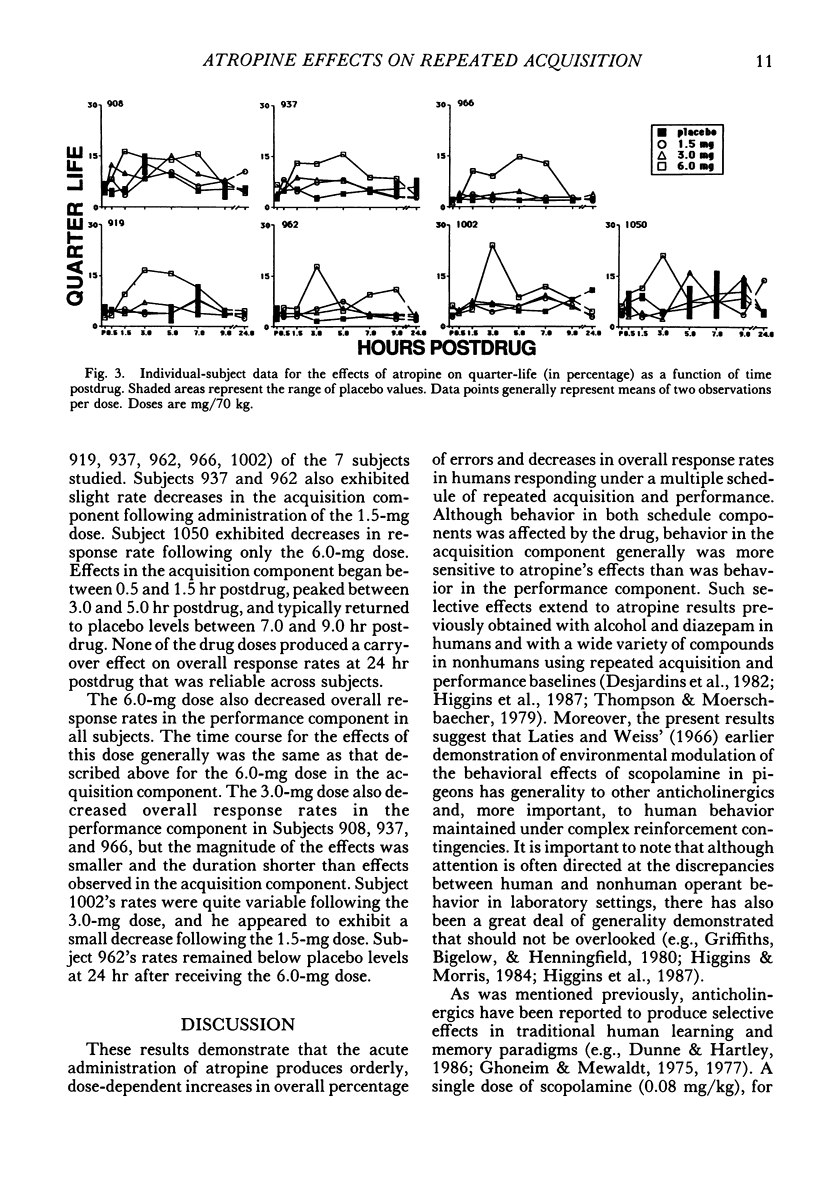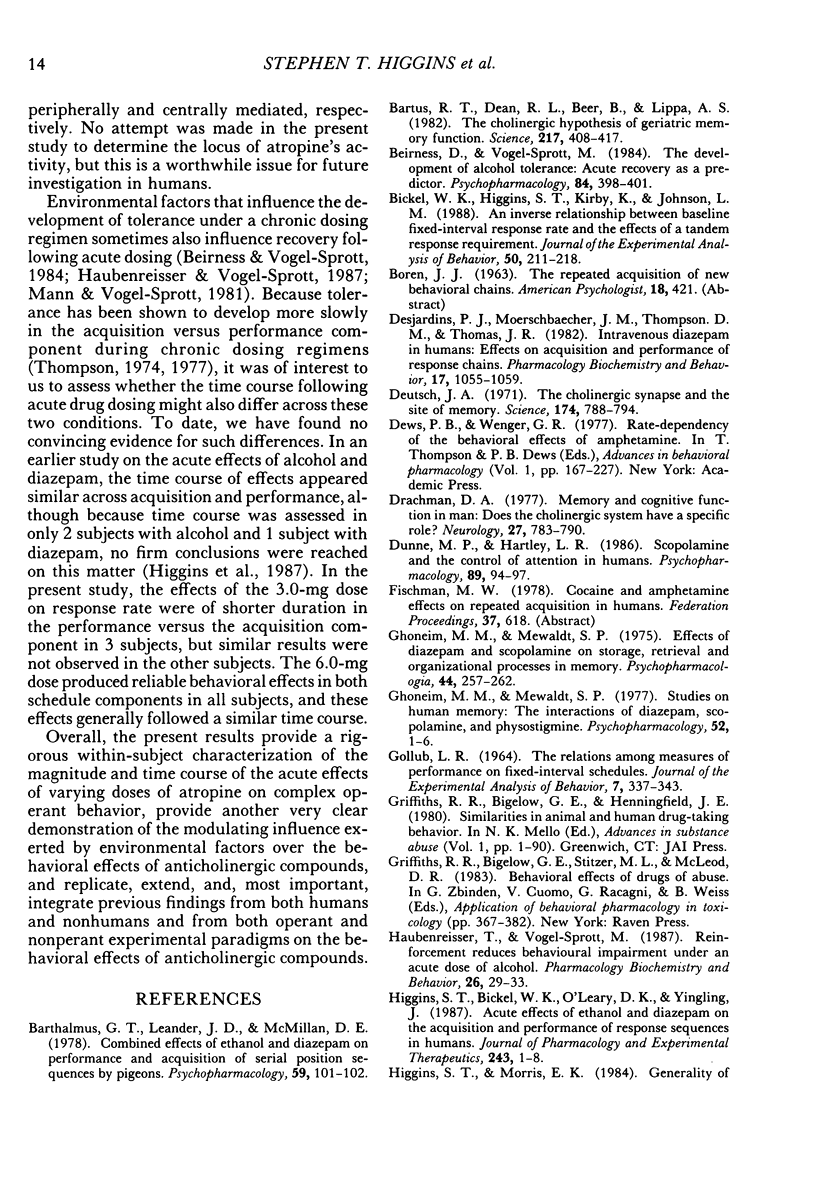Abstract
The present study assessed a 24-hr time course for the acute effects of intramuscular injections of atropine sulfate (0, 1.5, 3.0, and 6.0 mg/70 kg) in healthy adult humans responding under a two-component multiple schedule of repeated acquisition and performance of response sequences. Subjects resided in an inpatient research ward for the duration of the study. In each component of the multiple schedule, subjects completed a different sequence of 10 responses in a predetermined order using three keys of a numeric keypad. In the acquisition component, the subjects' task was to acquire a new sequence each session. Eight sessions were conducted daily: one immediately before administration of the drug and then 0.5, 1.5, 3.0, 5.0, 7.0, 9.0, and 24.0 hr after administration. In the performance component, the response sequence always remained the same. Overall percentage of errors increased and overall response rates decreased in the acquisition and performance components as an orderly function of drug dose. However, these effects were selective in that behavior in the acquisition component generally was affected at lower doses than in the performance component. When behavior was affected in both the acquisition and performance components, the time courses of effects were similar. Drug effects began at 0.5 or 1.5 hr, reached peak effects between 3.0 and 5.0 hr, and returned to placebo levels between 7.0 and 9.0 hr postdrug in both schedule components. None of the drug doses produced reliable effects the day after drug administration (24-hr postdrug) in either schedule component. The present study provides the first within-subject assessment of the magnitude and duration of the effects of an anticholinergic on repeated acquisition and performance baselines and extends to atropine the selective effects on these two baselines demonstrated previously with other compounds in humans and nonhumans.
Full text
PDF










Selected References
These references are in PubMed. This may not be the complete list of references from this article.
- Barthalmus G. T., Leander J. D., McMillan D. E. Combined effects of ethanol and diazepam on performance and acquisition of serial position sequences by pigeons. Psychopharmacology (Berl) 1978 Sep 15;59(1):101–102. doi: 10.1007/BF00428039. [DOI] [PubMed] [Google Scholar]
- Bartus R. T., Dean R. L., 3rd, Beer B., Lippa A. S. The cholinergic hypothesis of geriatric memory dysfunction. Science. 1982 Jul 30;217(4558):408–414. doi: 10.1126/science.7046051. [DOI] [PubMed] [Google Scholar]
- Beirness D., Vogel-Sprott M. The development of alcohol tolerance: acute recovery as a predictor. Psychopharmacology (Berl) 1984;84(3):398–401. doi: 10.1007/BF00555220. [DOI] [PubMed] [Google Scholar]
- Bickel W. K., Higgins S. T., Kirby K., Johnson L. M. An inverse relationship between baseline fixed-interval response rate and the effects of a tandem response requirement. J Exp Anal Behav. 1988 Sep;50(2):211–218. doi: 10.1901/jeab.1988.50-211. [DOI] [PMC free article] [PubMed] [Google Scholar]
- Desjardins P. J., Moerschbaecher J. M., Thompson D. M., Thomas J. R. Intravenous diazepam in humans: effects on acquisition and performance of response chains. Pharmacol Biochem Behav. 1982 Nov;17(5):1055–1059. doi: 10.1016/0091-3057(82)90493-2. [DOI] [PubMed] [Google Scholar]
- Deutsch J. A. The cholinergic synapse and the site of memory. Science. 1971 Nov 19;174(4011):788–794. doi: 10.1126/science.174.4011.788. [DOI] [PubMed] [Google Scholar]
- Drachman D. A. Memory and cognitive function in man: does the cholinergic system have a specific role? Neurology. 1977 Aug;27(8):783–790. doi: 10.1212/wnl.27.8.783. [DOI] [PubMed] [Google Scholar]
- Dunne M. P., Hartley L. R. Scopolamine and the control of attention in humans. Psychopharmacology (Berl) 1986;89(1):94–97. doi: 10.1007/BF00175197. [DOI] [PubMed] [Google Scholar]
- GOLLUB L. R. THE RELATIONS AMONG MEASURES OF PERFORMANCE ON FIXED-INTERVAL SCHEDULES. J Exp Anal Behav. 1964 Sep;7:337–343. doi: 10.1901/jeab.1964.7-337. [DOI] [PMC free article] [PubMed] [Google Scholar]
- Ghoneim M. M., Mewaldt S. P. Effects of diazepam and scopolamine on storage, retrieval and organizational processes in memory. Psychopharmacologia. 1975 Nov 21;44(3):257–262. doi: 10.1007/BF00428903. [DOI] [PubMed] [Google Scholar]
- Ghoneim M. M., Mewaldt S. P. Studies on human memory: the interactions of diazepam, scopolamine, and physostigmine. Psychopharmacology (Berl) 1977 Mar 23;52(1):1–6. doi: 10.1007/BF00426592. [DOI] [PubMed] [Google Scholar]
- Haubenreisser T., Vogel-Sprott M. Reinforcement reduces behavioural impairment under an acute dose of alcohol. Pharmacol Biochem Behav. 1987 Jan;26(1):29–33. doi: 10.1016/0091-3057(87)90528-4. [DOI] [PubMed] [Google Scholar]
- Higgins S. T., Bickel W. K., O'Leary D. K., Yingling J. Acute effects of ethanol and diazepam on the acquisition and performance of response sequences in humans. J Pharmacol Exp Ther. 1987 Oct;243(1):1–8. [PubMed] [Google Scholar]
- Higgins S. T., Morris E. K. Generality of free-operant avoidance conditioning to human behavior. Psychol Bull. 1984 Sep;96(2):247–272. [PubMed] [Google Scholar]
- Ketchum J. S., Sidell F. R., Crowell E. B., Jr, Aghajanian G. K., Hayes A. H., Jr Atropine, scopolamine, and ditran: comparative pharmacology and antagonists in man. Psychopharmacologia. 1973 Jan 1;28(2):121–145. doi: 10.1007/BF00421398. [DOI] [PubMed] [Google Scholar]
- Laties V. G., Weiss B. Influence of drugs on behavior controlled by internal and external stimuli. J Pharmacol Exp Ther. 1966 Jun;152(3):388–396. [PubMed] [Google Scholar]
- Levy A., Elsmore T. F., Hursh S. R. Central vs peripheral anticholinergic effects on repeated acquisition of behavioral chains. Behav Neural Biol. 1984 Jan;40(1):1–4. doi: 10.1016/s0163-1047(84)90122-5. [DOI] [PubMed] [Google Scholar]
- Mann R. E., Vogel-Sprott M. Control of alcohol tolerance by reinforcement in nonalcoholics. Psychopharmacology (Berl) 1981;75(3):315–320. doi: 10.1007/BF00432446. [DOI] [PubMed] [Google Scholar]
- Moerschbaecher J. M., Thompson D. M., Winsauer P. J. Effects of heroin, methadone, LAAM and cyclazocine on acquisition and performance of response sequences in monkeys. Pharmacol Biochem Behav. 1983 Oct;19(4):701–710. doi: 10.1016/0091-3057(83)90348-9. [DOI] [PubMed] [Google Scholar]
- Peele D. B., Baron S. P. Effects of scopolamine on repeated acquisition of radial-arm maze performance by rats. J Exp Anal Behav. 1988 Mar;49(2):275–290. doi: 10.1901/jeab.1988.49-275. [DOI] [PMC free article] [PubMed] [Google Scholar]
- Penetar D. M. The effects of atropine, benactyzine, and physostigmine on a repeated acquisition baseline in monkeys. Psychopharmacology (Berl) 1985;87(1):69–76. doi: 10.1007/BF00431781. [DOI] [PubMed] [Google Scholar]
- Perone M., Baron A. Age-related effects of pacing on acquisition and performance of response sequences: an operant analysis. J Gerontol. 1982 Jul;37(4):443–449. doi: 10.1093/geronj/37.4.443. [DOI] [PubMed] [Google Scholar]
- Perry E. K. The cholinergic system in old age and Alzheimer's disease. Age Ageing. 1980 Feb;9(1):1–8. doi: 10.1093/ageing/9.1.1. [DOI] [PubMed] [Google Scholar]
- Picker M., Poling A. Effects of anticonvulsants on learning: performance of pigeons under a repeated acquisition procedure when exposed to phenobarbital, clonazepam, valproic acid, ethosuximide and phenytoin. J Pharmacol Exp Ther. 1984 Aug;230(2):307–316. [PubMed] [Google Scholar]
- Thompson D. M. Development of tolerance to the disruptive effects of cocaine on repeated acquisition and performance of response sequences. J Pharmacol Exp Ther. 1977 Nov;203(2):294–302. [PubMed] [Google Scholar]
- Thompson D. M. Repeated acquisition as a behavioral base line for studying drug effects. J Pharmacol Exp Ther. 1973 Feb;184(2):506–514. [PubMed] [Google Scholar]
- Thompson D. M. Repeated acquisition of behavioral chains under chronic drug conditions. J Pharmacol Exp Ther. 1974 Mar;188(3):700–713. [PubMed] [Google Scholar]
- Thompson D. M. Repeated acquisition of response sequences: stimulus control and drugs. J Exp Anal Behav. 1975 May;23(3):429–436. doi: 10.1901/jeab.1975.23-429. [DOI] [PMC free article] [PubMed] [Google Scholar]
- Vaughan M. E. Repeated acquisition in the analysis of rule-governed behavior. J Exp Anal Behav. 1985 Sep;44(2):175–184. doi: 10.1901/jeab.1985.44-175. [DOI] [PMC free article] [PubMed] [Google Scholar]
- Wesnes K., Revell A. The separate and combined effects of scopolamine and nicotine on human information processing. Psychopharmacology (Berl) 1984;84(1):5–11. doi: 10.1007/BF00432014. [DOI] [PubMed] [Google Scholar]
- Wesnes K., Warburton D. M. Effects of scopolamine on stimulus sensitivity and response bias in a visual vigilance task. Neuropsychobiology. 1983;9(2-3):154–157. doi: 10.1159/000117954. [DOI] [PubMed] [Google Scholar]


